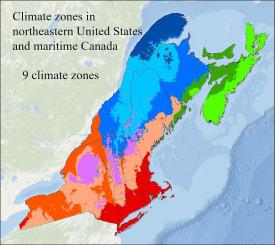当前位置:
X-MOL 学术
›
Ecol. Indic.
›
论文详情
Our official English website, www.x-mol.net, welcomes your feedback! (Note: you will need to create a separate account there.)
Influence of climate zone shifts on forest ecosystems in northeastern United States and maritime Canada
Ecological Indicators ( IF 6.9 ) Pub Date : 2024-03-25 , DOI: 10.1016/j.ecolind.2024.111921 Samuel Roy , Xinyuan Wei , Aaron Weiskittel , Daniel J. Hayes , Peter Nelson , Alix Contosta
Ecological Indicators ( IF 6.9 ) Pub Date : 2024-03-25 , DOI: 10.1016/j.ecolind.2024.111921 Samuel Roy , Xinyuan Wei , Aaron Weiskittel , Daniel J. Hayes , Peter Nelson , Alix Contosta

|
Climate zones play a significant role in shaping the forest ecosystems located within them by influencing multiple ecological processes, including growth, disturbances, and species interactions. Therefore, delineation of current and future climate zones is essential to establish a framework for understanding and predicting shifts in forest ecosystems. In this study, we developed and applied an efficient approach to delineate regional climate zones in the northeastern United States and maritime Canada, aiming to characterize potential shifts in climate zones and discuss associated changes in forest ecosystems. The approach comprised five steps: climate data dimensionality reduction, sampling scenario design, cluster generation, climate zone delineation, and zone shift prediction. The climate zones in the study area were delineated into four different orders, with increasing subzone resolutions of 3, 9, 15, and 21. Furthermore, projected climate normals under Shared Socioeconomic Pathways 4.5 and 8.5 scenarios were used to predict the shifts in climate zones until 2100. Our findings indicate that climate zones characterized by higher temperatures and lower precipitation are expected to become more prevalent, potentially becoming the dominant climate condition across the entire region. Thes changes are likely to alter regional forest composition, structure, and productivity. In short, such shifts in climate underscore the significant impact of environmental change on forest ecosystem dynamics and carbon sequestration potential.
中文翻译:

气候带变化对美国东北部和加拿大沿海森林生态系统的影响
气候带通过影响多种生态过程(包括生长、干扰和物种相互作用),在塑造其内的森林生态系统方面发挥着重要作用。因此,划分当前和未来的气候带对于建立理解和预测森林生态系统变化的框架至关重要。在这项研究中,我们开发并应用了一种有效的方法来描绘美国东北部和加拿大沿海地区的区域气候区,旨在描述气候区的潜在变化并讨论森林生态系统的相关变化。该方法包括五个步骤:气候数据降维、采样场景设计、聚类生成、气候区划定和区域转移预测。研究区域的气候带被划分为四个不同的等级,分区分辨率逐渐增加为 3、9、15 和 21。此外,使用共享社会经济路径 4.5 和 8.5 情景下的预测气候正常值来预测气候带的变化直到 2100 年。我们的研究结果表明,以较高气温和较低降水为特征的气候带预计将变得更加普遍,有可能成为整个地区的主要气候条件。这些变化可能会改变区域森林的组成、结构和生产力。简而言之,这种气候变化凸显了环境变化对森林生态系统动态和碳固存潜力的重大影响。
更新日期:2024-03-25
中文翻译:

气候带变化对美国东北部和加拿大沿海森林生态系统的影响
气候带通过影响多种生态过程(包括生长、干扰和物种相互作用),在塑造其内的森林生态系统方面发挥着重要作用。因此,划分当前和未来的气候带对于建立理解和预测森林生态系统变化的框架至关重要。在这项研究中,我们开发并应用了一种有效的方法来描绘美国东北部和加拿大沿海地区的区域气候区,旨在描述气候区的潜在变化并讨论森林生态系统的相关变化。该方法包括五个步骤:气候数据降维、采样场景设计、聚类生成、气候区划定和区域转移预测。研究区域的气候带被划分为四个不同的等级,分区分辨率逐渐增加为 3、9、15 和 21。此外,使用共享社会经济路径 4.5 和 8.5 情景下的预测气候正常值来预测气候带的变化直到 2100 年。我们的研究结果表明,以较高气温和较低降水为特征的气候带预计将变得更加普遍,有可能成为整个地区的主要气候条件。这些变化可能会改变区域森林的组成、结构和生产力。简而言之,这种气候变化凸显了环境变化对森林生态系统动态和碳固存潜力的重大影响。



























 京公网安备 11010802027423号
京公网安备 11010802027423号